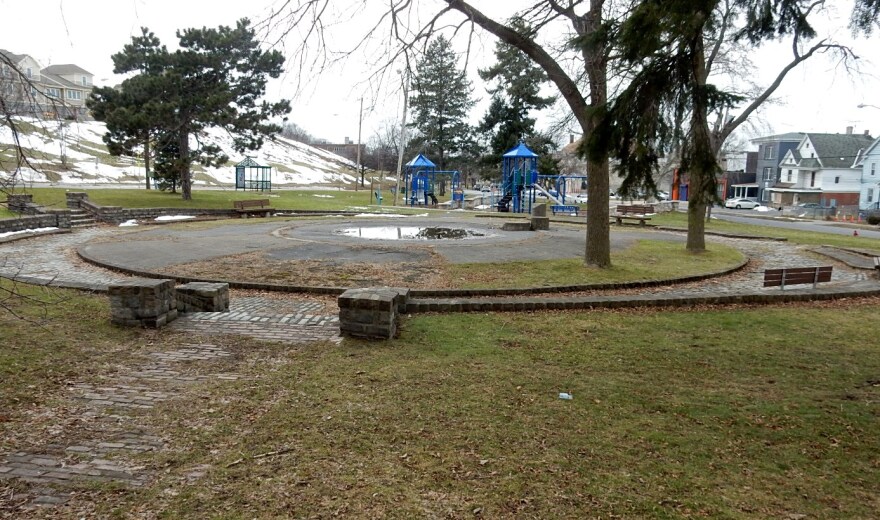Many people have walked or driven right past one of the most prolific passageways of the Underground Railroad in Syracuse…and never even knew it. Why is an unassuming street corner in Syracuse really an important weigh station of history?
You very well might have driven past the intersection of East Genesee Street and Pine…maybe thousands of times. Writer and local resident Madis Senner had a friend that lived just a few doors down.
“I used to come here all the time in my late teens, early 20s. I did know anything about it; neither did anyone else in Syracuse, which is a tragedy.”
What he’s talking about is the home of Reverend Jermain Loguen, a prominent – but not always front-and-center figure - in the area’s connection to the Underground Railroad.
“what, 1500 people, passengers on the Underground Railroad passed through his house. He was blatantly open about his [practice. He would hand out cards saying, “Underground Railroad, I’m a conductor.’ He dedicated his life to helping freedom seekers find freedom”
Senner and others note that it’s a shame Loguen’s home was never preserved as an historic site. If you’re trying to envision the property, it’s now a Rite Aid drug store. Senner links Loguen’s home with Tubman’s and other abolitionists’ as not just historic, but having a certain spirituality to them – something we’ll talk about a little later.

Robert Djed Snead also found out Loguen was very public with his support for freedom seekers…runaway slaves.
“if you knew of, or there was a person who had escaped slavery and had made their way to Syracuse, could come to 293 east Genesee street, and as he said, he would make them most welcome.”
He might help them get a job, or find passage to Canada. Snead found out a lot about Jermain Loguen as he developed a performance in which he portrays the Reverend in historic reenactments.
Loguen escaped slavery himself in 1837 to Canada, but made his way back to Rochester to work. He gained some education at the Oneida Institute in Whitesboro where Snead believes he developed confidence to speak out against slavery.
“He truly believed that if you did not treat others the way you wanted to be treated, then you were not doing god’s will. I think that is what drove his actions, what drove his speaking, what drove his life.”
He became a speaker decrying the 1850 fugitive slave law – at events central to Syracuse history.
“o.k., Is Syracuse going to be complying with this law? Or is Syracuse going to fight with all of its might. And … [Loguen] says, ‘I outlaw this law and it outlaws me.’”
Snead found Loguen was not shy about putting his own freedom on the line
“He said, ‘Many people have offered to buy my freedom, but I refuse it. My freedom was given to me by the god who created me. And with giving me that freedom, he gave me the right to defend it against any and everybody and thing.’ That’s the sense I get from him. He was a warrior.”
Loguen was front and center in the Jerry Rescue…where a large crowd rose up to free a man caught under the fugitive slave law…an event that resonated nationally for Syracuse and abolitionists at the time, who wanted to challenge the law. We’ll examine that story in a later piece. Loguen remained a prominent and dedicated figure in the cause.
“He was friends with Douglass, he was friends with John Brown; He was friends with Harriet Tubman. And from my research, he used all of his energy, all of his resources, to sometimes the chagrin of his wife and family, to do god’s will.”
Loguen’s history, while known to some, might have been a bit drowned out by other local stories and figures of note – Harriet Tubman, who traveled through Syracuse and lived in Auburn; Frederick Douglass from nearby Rochester; or the Jerry Rescue.
“He should be remembered and uplifted. I’ll put it like this, in his day and time, he was as recognized, as famous as those individuals like a Douglass or a Tubman….”
Alas, Snead says, Loguen wasn’t as literate …plus he adds history only remembers one or two main players from any era.
MORE THOUGHTS ABOUT THE LOGUEN HOMESITE AT GENESEE AND PINE STREETS
There might be more going on at Loguen’s home and other historic properties in abolition history. Madis Senner wrote the book Sacred Sites in North Star Country…in which he links Loguen’s home to others.
“Frederick Douglass’ home, near Highland Park, Harriet Tubman’s home, William Seward’s home, Gerrit Smith’s home, all have these fields of consciousness. And so they were very close to where these consciousness emanated. Either they were drawn there or motivated it…and it nourished their souls.”
Something Senner finds too much to be a coincidence. In his book he notes such sites are prominent in abolition, but also the women’s rights movement, Haudenosaunee history – often called the basis for democracy, religious movements and other spiritualism. Perhaps another reason Loguen’s home should have been preserved.
LOGUEN HONORED, JUST NOT AT HIS HOME

If you walk by, there is a placard at the corner with Loguen’s story and other nearby Freedom trail sites. Loguen is also remembered by a park that bears his name just up Genesee street from his former home site. Kids using the playground – or adults enjoying a break at the park probably don’t connect their freedom to do so with Jermain Loguen’s efforts more than a century and a half ago in Syracuse’s history.
In future installments of C-N-Y Unknown Underground, we’ll hear a few more details about the Jerry Rescue …and some of the history of the sculpture in Clinton Square that commemorates it.
We’ll also learn that one of the local prominent sites in the women’s rights and movement was also an Underground Railroad station.
Next up…tune in Friday for the story of a local man who gave away much of his extensive family fortune to help escaped slaves find freedom. Installments of
C-N-Y Unknown Underground will also be on our website, WAER.org.






